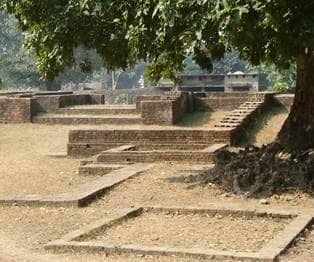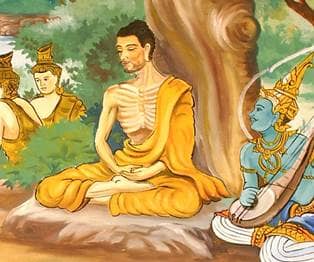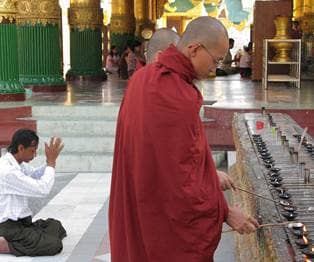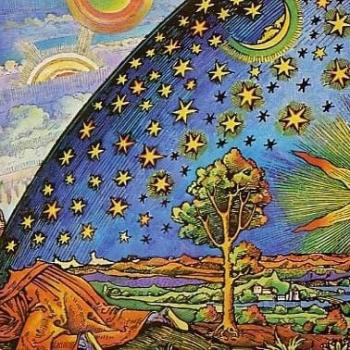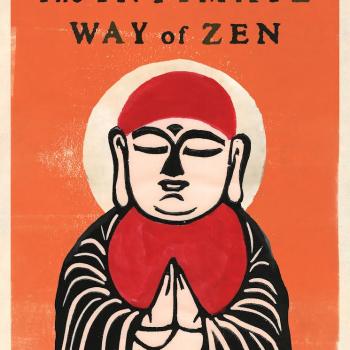- Trending:
- Olympics
- |
- Forgiveness
- |
- Resurrection
- |
- Joy
- |
- Afterlife
- |
- Trump
Buddhism Origins
Beginnings
KEY CONCEPTS IN THIS SECTION:
Founder: Siddhartha Gautama (c. 5th century B.C.E.)
Origin: India
Spiritual teaching: Four Noble Truths: 1) human life is full of suffering; 2) suffering stems from cravings for pleasure and avoidance of pain; 3) suffering can be eradicated; 4) the path of freedom from suffering is the path of enlightenment
Followers: the sangha, a community of monks
Ethical guidelines: not to take human life, not to lie, not to steal, not to use intoxicants, not to engage in illicit sexual behavior
First Buddhist ruler: Ashoka
Where did Buddhism originate?
Buddhism evolved from the teachings of Siddhartha Gautama who was born in the 5th century B.C.E. (some scholars have argued for the 4th century B.C.E.) in the Indian state of Kapilavastu, now part of Nepal. Born a prince, the young man who would become the Buddha renounced a life of wealth and power, according to Buddhist texts, to become a spiritual seeker. Many scholars agree that Buddhism originated in the current country Nepal, once part of India.
After years of wandering and asceticism he became enlightened — that is, he had a realization about his own true nature. He saw that his own thinking was the only obstacle preventing the spiritual understanding he had been seeking. That obstacle was removed when he realized that his sense of himself as a separate and isolated individual was an illusion. He thus escaped from desire and suffering, and was called "The Buddha," or the Awakened One.
Buddhism Beginnings and Early Formation
In a deer park in the small town of Sarnath, outside modern Banaras, the Buddha preached his first sermon, in which he outlined four interrelated spiritual truths, often called the Four Noble Truths. These were:
- Suffering is characteristic of human existence;
- Suffering is caused by longing for pleasure and avoidance of pain;
- It is not necessary to suffer; and
- There is a path to end suffering.
His sermons moved many who heard him speak and he began to gather disciples. These followers became the first sangha, or community of monks.
At first, only men followed the Buddha as monks. Later, women were also allowed to become nuns, but with many restrictions reflecting the social customs of the time. According to Buddhist texts, the Buddha objected to this at first, but was persuaded by his disciple Ananda to admit women. Some of the early texts also suggested that women could not become enlightened, but must first be reborn as men. Feminist scholars of Buddhism believe that these stories are later additions to the texts that reflect attitudes toward women in those times.
Some early Buddhist texts mention both men and women who, like the Buddha, became enlightened. The earliest disciples, called arhat, also attained enlightenment and were sent by the Buddha to wander and teach on their own. Soon there were many new converts and the new religion rapidly gained large numbers of followers.
In the beginning, all of the Buddha's followers gave up home, family, social status, and possessions, and begged for their meals. They were taught that this was the way to become detached from material things and social status, which would hinder an individual's enlightenment. Sexual activity was also prohibited, as were intoxicants, comfortable seats or beds, and any form of entertainment. Monks were not allowed to handle money and were permitted only one meal a day.
Those who appreciated the Buddha's teachings but were unable or unwilling to give up all their possessions and their social status supported the monks by providing food, clothing, and shelter. These lay followers were given five precepts: not to take human life, not to lie, not to steal, not to take intoxicants, and not to participate in illicit sexual activity. Their support earned them merit, which would facilitate rebirth as an individual who would be free to pursue spiritual goals.
The Buddha allowed people of all castes, and those of no caste, to join the sangha. Many became monks, but lay people also joined in large numbers. Among these were people of low status as well as wealthy merchants and rulers.
Although the first Buddhist monks were all wanderers, wealthy lay supporters soon began to donate land to the monks, originally for places to stay during the monsoon season and later for permanent dwellings and places for meditation and teaching. These became the first Buddhist monasteries. Soon this organization of itinerant monks had acquired, paradoxically, extensive holdings of land, which led to strict monastic rules about the use of this property, and which also led to some tensions between Buddhist monks and political rulers.
The conversion of two powerful rulers also quieted some of the political wrangling. Converting to Buddhism accorded the rulers a higher religious status than they had held within the traditional caste system. The strict moral expectations of Buddhism also appealed to some rulers because it eased the burden of maintaining social stability. In turn, the Buddha expressed a vision of an ideal society in which selfless and fair rulers would distribute their wealth among the people.
Within a few centuries after the Buddha's death, Chandragupta Maurya of Magadha would unite most of what is now called India into an empire. His grandson, Ashoka, converted to Buddhism a few years after he took the throne. At first Ashoka did not take his conversion seriously, but after leading a bloody conquest of the northeastern state of Kalinga, he experienced remorse and began to take Buddhism to heart. He decided to apply the Buddha's Dharma, or teachings, to his government and to spread the word of the Buddha throughout the empire and beyond. He erected dozens of huge stone pillars inscribed with basic Buddhist teachings, built monasteries, and created shelters for Buddhist pilgrims. Ashoka became the model for many subsequent rulers throughout Asia who affiliated themselves with Buddhism.
- Who was the Buddha?
- What were the lessons taught in the Buddha's first sermon?
- How did Buddhism initially spread?
- What did individuals have to renounce to become a Buddhist? What happened if they couldn't or wouldn't renounce such things?
Influences
At the time of the Buddha's birth, a religious tradition based on sacrifice to powerful and sometimes capricious deities had dominated the land we now call India since 1500 B.C.E., but was yielding to new religious ideas that had been emerging for several centuries. Among these were karma and reincarnation, which had been readily adopted, and may have represented the revival and reconceptualization of ancient ideas already present within the culture.
According to this structure of beliefs, one's social status was a result of one's karma. Deeds in previous lives determined the level of one's rebirth. Social inequalities were thus justified by religion, in a land where social mobility was impossible. This system left no place for arguments for social justice or equality. Because upward movement was believed to require many lifetimes, those of the lower classes now had the dual burden of hopelessness in life and little hope of betterment for lifetimes to come.
At the same time, the region was undergoing political and social change as new city states linked by trade replaced older agriculturally based communities bound by ties of kinship. A growing number of merchants had attained economic success, but their social and religious status was limited by the caste system. Additionally, trade routes across Asia — most notably the renowned Silk Route — brought new social and religious ideas to the northern Indian subcontinent from China and central Asia. The new rulers and the merchants were eager for a religion that awarded them higher social status as well as the opportunity to attain salvation, which at the time was believed to be possible only for those of the highest caste, the priests.
While some continued to enjoy their homes, families, and work, a few developed a thirst for spiritual attainment so strong that they began to renounce worldly possessions and family connections in order to devote themselves completely to meditation and other spiritual practices. They were called shramanas, or renunciants. Spiritual teachers made themselves available to those who wanted guidance, teaching asceticism, meditation, and yogic practices. The spiritual heat, or tapas, generated by spiritual practice was regarded as equivalent to the fire of the sacrifices that had been the focal point of the old tradition. Thus was the old tradition internalized and transformed.
A new collection of religious texts, called the Upanishads, or "sitting by the [spiritual] teacher," is a record of some of these teachings. Many of the Upanishads contain the idea that one's individual self, or atman, is part of the ultimate reality, or Brahman. Through meditation, an individual could attain moksha, or spiritual liberation, simply by realizing the true nature of the self. This release was a way of transcending samsara, the endless cycle of death and rebirth.
The Buddha's enlightenment would take that realization a step further, as he taught that there was no individual (anatta). The experience of a separate self is only an illusion. If there is no self, there is nothing to accumulate karma, nothing to be reborn. To realize that there is no self is to be liberated from samsara forever.
- How did religion justify the perpetuation of a caste system in the time of the Buddha's birth?
- Describe the political changes that gave rise to Buddhism.
- How did the ritual of sacrifice change with the emergence of Buddhism?
- What is samsara, and how can the individual escape it?
Founders
Born a wealthy prince in the state of Kapilavastu, in what would become India, as a young man Siddhartha Gautama became discontented with his life. He had wealth, power, a beautiful wife, a healthy son — everything a young man could want. He came to the realization, however, that all of these things were fleeting. Someday he, like everyone else, would become sick and old, and someday he would die. He realized that all of his material things and social benefits provided only temporary happiness, so he gave it all up to become an ascetic. Leaving his wife and infant son behind, as well as the kingdom he was to inherit, he began to wander in search of the meaning and purpose of human existence.
He studied with various teachers who were also renunciants. He tried many paths, the last of which called for six years of extreme self-deprivation. Eventually, he decided that this path was not working for him, and determined that he would sit in meditation until he found an answer. After a long night of meditative visions and insights, he was enlightened, becoming "The Buddha," or the Awakened One.
The Buddha did not represent himself as a supernatural being; he said he was simply a man who had a realization about the nature of human existence. In fact, he taught that only a human being could become enlightened. Nonetheless, after his death many legends about him arose.
Legends of his birth told that his mother was impregnated as she dreamed of a white elephant, and that she gave birth to him standing up, through her armpit. Another legend told how as a young man, he vied with others for the hand of a beautiful young woman, and demonstrated both intellectual and athletic prowess in winning her hand.
At the time of his birth, astrologers were said to have predicted that he would become either a great ruler or a great spiritual teacher. His father therefore tried to shield him from awareness of sickness, old age, and death, but the gods conspired with his chariot driver one day to take him past a sick man, an old man, and a corpse. That night he left home to spend years in spiritual study and ascetic living.
It was said that he lived on a grain of rice a day, and became so thin he could feel his backbone when he pressed upon his stomach. One day, after fainting from hunger, a young woman offered him a bowl of rice milk (or porridge) and he ate it all. This simple meal gave him the strength to continue his quest. He threw the bowl into a river, saying, "If this bowl floats upstream, I am to become a Buddha today." The bowl floated upstream.
Coming upon a tree now known as the Bodhi tree, in the small town of Bodhgaya, he decided to sit there until he attained enlightenment. During the night, Mara, the tempter, deity of desire, appeared and put him through many trials. Mara pounded him with violent storms. He created the illusion of a massive army shooting at Gautama with flaming arrows. When these failed, he sent his beautiful daughters to tempt him. Ignoring all these distractions, Siddhartha continued to meditate through the night until at last he attained realization. At the moment he became enlightened, the Buddha touched the earth as his witness and the earth trembled.
After about forty-five years as a spiritual teacher, the Buddha died. The cause of his death is not clear, but it was apparently some kind of food poisoning. According to legend, he was aware before he ate it that the food was deadly and he protected others from eating it. His body was cremated, and various relics taken from the remains were distributed. These remains of his physical body were believed to have sacred power. Eventually they were interred in stupas, which became important Buddhist symbols and objects of veneration.
Over the centuries, legends of the Buddha's previous lives emerged and were recorded as the Jataka Tales. It was said that in one life he was a rabbit who came across a hunter lost in the woods and starving. First shaking the fleas from his fur, so as not to sacrifice their lives too, he leapt into the hunter's fire in order to offer himself up as a meal. Another of these tales tells of a lifetime as an elephant that jumped from a cliff to provide food for hundreds of starving men.
Still later, the notion developed that there were many Buddhas in the universe, that Buddhas had been incarnated as humans many times previously, and that more would emerge in the future. It was predicted that Maitreya, the next Buddha to come, would appear sometime in the distant future.
- Why did Siddhartha Gautama become an ascetic?
- What was significant about Siddhartha's birth?
- Why was the Buddha's body distributed upon his death?
- Should the Buddha be considered a supernatural being? Why or why not?
Sacred Texts
The Buddha taught for forty-five years over a wide geographical area to a variety of different audiences, thus his teachings were quite extensive, yet at the time of his death none of his words had been recorded. Oral transmission of spiritual texts was not unusual in a land where memorization and recitation of religious texts was the standard. Even the classic texts of the oldest religious traditions had not been recorded in writing at that time.
The early Buddhist texts describe a legendary gathering of five hundred arhats (followers) for the purpose of standardizing the Buddha's teachings after his death. According to the texts, Ananda — the disciple who had most often accompanied the Buddha on his travels and was said to have a prodigious memory — recited the sermons of the Buddha. Another disciple, Upali, recited the rules for monks and lay followers. These recitations were memorized by others and passed on.
The Buddhist texts were not recorded in writing until centuries after the Buddha's death. The earliest Buddhist texts have preserved the Buddha's teachings in a form that reflects their oral transmission, with many repetitions, standardized phrases, and poetic rhythms. This structure and the lack of philosophical cohesiveness within these early texts suggest that they were intended not simply to convey the Buddha's teachings, but also to serve as religious recitations.
Even after the texts were recorded in writing, recitation of texts has continued to be an essential element of Buddhist practice. Monks and priests recite from the texts during rituals, and they also recite the texts as a form of meditation and training. Passages from the texts known as dharani and shorter phrases called mantra are believed to carry magical powers when repeated. Amulets with passages from the texts are distributed by temples as talismans. Copying popular texts such as the Lotus Sutra has been for many centuries a means of gaining religious merit. Even the texts themselves are considered sacred, and ancient copies of the Buddhist canon are often kept in special storehouses on temple grounds.
The texts are divided into three different collections, known as the Tripitaka, or "three baskets," perhaps because the texts were originally stored in baskets. One "basket," the Sutra Pitaka, consisted of the Buddha's discourses: stories, anecdotes, and examples that reflected his understanding of the path to enlightenment. The second "basket," the Vinaya Pitaka, contained guidelines for the monks that pertained to morality and social behavior, as well as institutional guidelines for the sangha.
The third "basket," called the Abhidharma Pitika, was created centuries later than the others, and emerged during the process of creating Buddhist philosophy. The sutras had been organized, not on the basis of their subject, but on the basis of length and other stylistic attributes. As a part of the process of developing cohesive systems of Buddhist thought, philosophers rearranged the sutras on the basis of topics, categories, and relationships between passages. The Abhidharma, or "higher teachings," was the result.
There are hundreds of texts in each of the three "baskets," and virtually all of them include at least one commentary explaining and expanding on the texts, with interpretations, definitions of words, and philosophical speculation.
Around four centuries after the Buddha's death, a new perspective on Buddhist thought began to develop called the Mahayana, or Great Vehicle. New sutras proliferated that were said to have been hidden away until the time was right for them to be made known to the world, since these texts were said to contain insights and powerful practices that the Buddha had taught secretly to those few who were ready to hear them. In each new country that adopted Buddhism, new sutras appeared. Mahayana sutras such as the Lotus Sutra, Heart Sutra, the Diamond Sutra, and the Vimalakirti Sutra became so popular in East Asia that in some cases, Buddhist sects emerged that were devoted to only one particular sutra.
The Buddhist canon today is not a uniform collection, as many different sects and schools have emerged over the centuries since the first canonical collection of the Buddha's teachings was formed. There is a Pali canon, the earliest of the canons, which consists of the Tripitaka. (Pali is a literary dialect related to Sanskrit, believed by some to have been common during the Buddha's lifetime, although it is most likely a later creation.) There is a Chinese Buddhist canon, also accepted in Japan, which contains the Tripitaka, the Mahayana sutras, and other texts. There is also a Tibetan Buddhist canon, consisting of the Tripitaka, the Mahayana sutras, and Tantric texts. Each of these different canons exists in different versions, depending on the sect of Buddhism to which a particular collection belongs and the time period in which it was created.
- How were the Buddha's teachings recorded?
- What are the Buddhist Tripitaka, and what is the purpose of each?
- Why did various Buddhist canons emerge?
Historical Perspectives
The focus of contemporary scholarly criticism of Western studies of Buddhism is what has been called the "Protestantization" of Buddhism; that is, the neglect of ritual and devotional activities in favor of an emphasis on meditation and the notion of "experience," and a shift in focus from the domination of clerical authority to lay participation.
One will often hear someone say, "Buddhism is not a religion; it's a philosophy." This assumption is based on distorted interpretations and on Western adaptations of the tradition. For most in Asian Buddhist countries, Buddhism is very much a religion. Typically, a lay Buddhist will visit a temple for the following reasons: to pray to a deity, through the medium of a statue of that deity, and leave a small gift, usually incense, fruit, or flowers; for a festival, such as New Year, Buddha's Birthday, or festivals involving the dead; or to arrange or participate in funerary rites on behalf of the dead.
Meditation does not play a prominent role even in most monastic situations, and a peak experience is not usually the goal of Buddhist practice. Western textbooks present elaborate schemes of states of consciousness through which one may progress in practice, taken from the Buddhist textual tradition, but very few monks actually engage with this sort of process. Critics argue that accounts of meditative experiences from later Buddhist texts are taken to be first-person experiences when they are merely scholarly descriptions. Although the early Buddhist texts emphasize enlightenment as the goal of Buddhist practice, critics suggest that this is seldom the case for today's Buddhist monks, most of who think of nirvana as an impossible goal in this lifetime.
Several traditions that have become popular in the West have focused on the practice of meditation: Zen, Vipassana, and Tantra. In each case, the participants are often people who are not monks, whereas it is rare in Asia for lay Buddhists to meditate. In the case of Zen Buddhism, followers are sometimes invited to participate in meditation, but meditation — and particularly the peak experience deriving from meditation — is not central in the way that it has become in the West. Expectations for these experiences have been created, in part, by the influence of Western scholars like Schleiermacher, Jung, or William James (The Varieties of Religious Experience) on late 19th- and 20th-century Japanese scholars.
In Southeast Asia, the modern Vipassana movement was inspired in part by Westerners. Two such influential Westerners were Henry Steel Olcott and Helena Blavatsky, founders of the Theosophical Society, who sparked a Buddhist revival movement in Sri Lanka in the late 19th century. Another arm of the Theravada revival movement, the Pali Text Society, was founded in London in 1881. Their translations made the ancient texts from which today's Western textbooks have taken their descriptions of intensive meditation practices and states of consciousness available to the West — and to most people in Southeast Asia — for the first time. Native movements emerged that engaged the Buddhist laity in meditation for the first time. These, in turn, gave birth to Vipassana meditation centers in the West.
In both the Japanese and Southeast Asian cases, meditation for lay Buddhists was encouraged for worldly reasons: to ease stress, promote psychological well-being, improve one's personal life, and so on. According to critics, these are the values that were extended to the West along with the new Buddhist meditation movements. The potential for psycho-spiritual peak experiences was also touted along with these new Buddhist practices. Robert Sharf, one of the most vocal critics of the "Protestantization" of Buddhism, does not deny that unusual experiences may occur for Western practitioners of meditation, but he does question those who equate these experiences to those described in the ancient texts.
Sharf also points out that the elaborate visualizations of deities, which some Westerners consider to be central to Tibetan and other Tantric Buddhist practices, are quite different from what some have been led to believe. Usually the practice consists of recitation of texts that describe these deities in great detail. The texts are recited very quickly, and often without comprehension or conscious thought. Sharf argues that there is no time or inclination to visualize within this context, and adds that his personal inquiries have confirmed his opinion.
Romanticized descriptions of Tibet have been another target of scholarly criticism. Portrayals of Tibet are often reminiscent of Lost Horizon, the 1933 novel by James Hilton that was turned into a 1937 film by Frank Capra. Lost Horizon depicts Shangri-la, a utopian land in the Himalayas (populated primarily by Caucasians, rather than Asians) run by "lamas," where the occupants never seem to age. While sensitive to the many cruelties associated with the Chinese invasion of Tibet, Donald Lopez and others have criticized a Western tendency to romanticize Tibetan culture and religion, pointing out that Tibet was never the utopian world that some have portrayed it to be. Even the former head of the Tibetan theocracy, the Dalai Lama, while objecting to the Chinese takeover, has also been clear in stating that there was a need for many reforms in Tibet.
All of these scholarly criticisms are vital to contemporary understandings of Buddhism, but critics must always be wary of seeming to continue Western attempts at intellectual dominance, as Western-influenced interpretations of Buddhism within Asia are, in turn, criticized by new generations of Western scholars. They must also be careful to avoid seeming to criticize all forms of Buddhism that have been exported to the West, potentially casting aspersions on the legitimate and sincere along with the spurious. It is also important to recognize that Buddhism has changed and adapted to different historical times and different cultural contexts many times in the past. Both the changes, and the criticism of the changes, are necessary and compelling aspects of the evolution of tradition — a process that is itself a worthy and often neglected object of study.
- What is meant by the “Protestantization" of Buddhism?
- How has the hegemony of Western religious thought change Buddhism?
- What about Buddhism has become popular in the West? How does this differ from the emphases of Buddhist monks?


